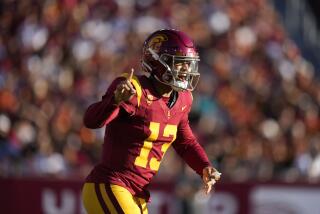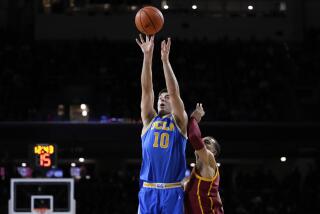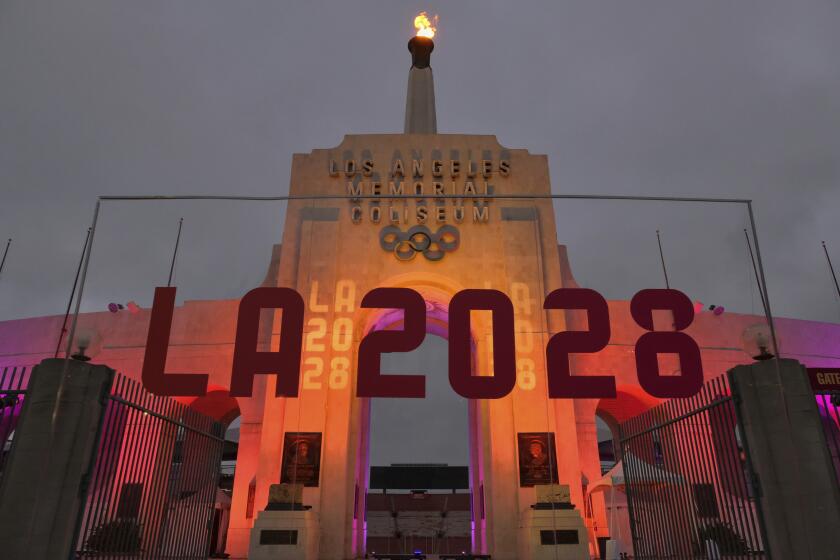Gary Williams Starts Anew at Maryland
- Share via
COLLEGE PARK, Md. — Before the first game he ever coached, Gary Williams bought a tie. That was 20 years ago, at Woodrow Wilson High School in Camden, N.J. He was 23.
“We knew we were going to be a good team,” Williams recalled, “because we had some good players back. So there was pressure on us -- and I was really concerned that we play well that first game, because as long as we played well we’d be all right the rest of the year.”
Wilson won its opener. Wilson won its second game, its third, its 10th, its 15th and so on through its 27th and last game of the season. Unbeaten and with a state championship, Williams figured he’d guessed right on a career choice.
“I really wanted to be a coach,” he said, “but I didn’t know how long I’d be in it (he had been Wilson’s jayvee coach the year before). And if I was ever going to be anything but a high-school coach.”
Quicker than he’d expected, Williams had flashed through seven seasons as a college assistant to Tom Davis, the first six years at Lafayette and the final one at Boston College. At 32, Williams once more was into fresh starts and early expectations as a head coach.
“My first game at AU (in 1978) was against St. John’s in the Lapchick Tournament. St. John’s never loses in that one, but we took ‘em to overtime. We had chances to win at the foul line, but missed and they won.
“So I scouted Wagner (AU’s probable opponent in the consolation game). They had it sort of set up for St. John’s to play Alabama for the championship. P.J. Carlesimo was at Wagner at the time, and they upset Alabama. C.M. Newton was angry, and they beat us pretty bad the next night. Then we lost to Navy before finally winning (against Catholic University).”
Williams won slightly more than 63 percent of his 114 games at AU and took his final two teams to the National Invitation Tournament. In 1982, he was off to Boston College.
“I don’t remember my first game at BC,” he said, “but the first Big East game was against Villanova. I was nervous (because the Big East was the Big Time). We lost that game, but we knew we had a good team. Won 25 games (with players that included future pros Jay Murphy and Michael Adams).”
After four seasons that ended with a 76-45 record, two trips to the NCAA tournament and another appearance in the NIT, Williams was off to a possibility bigger than BC, if not the Big East. A fellow could win the national championship at Ohio State.
“That was as rewarding a situation as I’ve ever gone into,” Williams said, recalling the hard work and leadership of a senior star (Dennis Hopson) and the surprising ability of a childish-looking sophomore named Jay Burson. “We weren’t sure we could play in the Big Ten, or anybody, really, because we were small and one guy hurt his knee and missed a couple of months.
“By the end of the year, we were as confident as any team I’ve ever coached. We beat Kentucky by 10 in the first round of the NCAAs in Atlanta. We had Georgetown down by 15 in the second half. That was when everybody discovered Charles Smith (who led the Hoyas to a comeback victory). We didn’t know he was capable of those kinds of things.”
Williams twisted some the other day in a midcourt seat inside Cole Field House. Twenty-two years later, he was back.
“I’ve never gone into a situation with a team that’s been picked preseason for last place in the conference. With these guys, it’s a confidence thing as much as anything, to get them to believe they can play.”
Practice had ended moments earlier. On hand for it was Frank Fellows, who had recruited Williams to Maryland. Fellows had been an assistant coach during Williams’ three-year playing career and hired him as a graduate aide after being promoted to replace Bud Millikan in 1967.
“Gary played like he coaches,” said Fellows, meaning at an intense but not out-of-control pace. Looking at the floor, Fellows saw Williams with two full-time assistants, one part-timer and a volunteer assistant. Fellows was all of those under Millikan.
“I was the guy on the road,” he said. “Scouting and recruiting. I remember Gary at a tournament in Trenton. He scored more than usual that night. Also, I was the head freshman coach and assisted with the varsity. Everybody else (in the ACC) had two (assistants) except Bud.”
Fellows, who was replaced by Lefty Driesell after going 16-34 for two seasons, smiled and said: “The next guy always gets a little more.”
Williams brought to Maryland a fairly full head of gray hair that began sprouting his third year at AU. Also, much of the terminology Maryland’s point guard yells this season is exactly what Williams shouted when he assumed the position as a Terrapin 25 years ago.
Plays are nice, Williams knows. Players are better. And, yes, Williams bought another tie before his first game as Maryland’s coach.
“Every once in a while,” he said of his players, some of whom are under their third head coach at Maryland, “they get fragile, lose their confidence. They go along, improving, improving, playing pretty well. All of a sudden, they fall back.
“Sometime there will be something in the papers about the NCAA (investigation, which is supposed to end in mid-February with an announcement of Maryland’s penalty).” You can almost tell that day in practice.
“I’ve tried to be real honest, sell them on the idea that they should enjoy the moment of being college basketball players. Not be concerned with what they’ve had to be concerned with the last couple of years. Let’s play the games. Play. It’s hard, though.”
More to Read
Go beyond the scoreboard
Get the latest on L.A.'s teams in the daily Sports Report newsletter.
You may occasionally receive promotional content from the Los Angeles Times.










